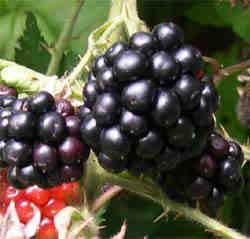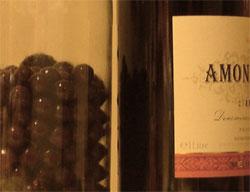Blackberry and apple jelly best recipe
Posted by Fiona Nevile in Jam Jelly and Preserves | 85 comments
Fat juicy blackberries in our garden
Try and pick the blackberries when the sun has been on them; midday is ideal. For the apples, we use windfalls because they are bruised and will not keep even though they might look perfect. Blackberry and apple jelly is sometimes referred to as hedgerow jelly.
If this is the first time that you have made jelly, check out the tips and tricks below, as some of the terms are a bit quirky. Making jelly is easy, you can cook the fruit one evening and make the jelly the next. (Generally, with jam and chutney, the whole procedure has to be done in one sitting).
We also have an old family recipe for blackberry and apple jam here.
You will need a heavy bottomed saucepan or Maslin pan.
Recipe for Blackberry and Apple Jelly
Ingredients:
- 2lbs/900gms of apples (windfalls or any apples are fine for this recipe)
- 2lbs/900gms of blackberries
- water (see method below)
- White granulated sugar (the amount depends on the volume of juice extracted from the simmered, drained fruit. Ipt/500ml of juice to 1lb/454gms of sugar. I always make sure that I have a 2 kilo bag of sugar in the larder, just in case I fancy making jelly).
Method:
- Wash the apples, cut out bruised bits and chop roughly. There is no need to peel and core the apples.
- Pick over the blackberries, reject any that are tatty and remove any stalks.
- Place fruit in a large deep heavy bottomed saucepan, or preserving pan. Add water to cover ½ of the fruit.
- Bring slowly to the boil and simmer very gently until all the fruit is soft and squishy. This takes about 15 minutes, depending on how ripe the fruit is.
- Pour the cooked fruit into a jelly bag and leave to drip into a bowl overnight. (What is a jelly bag? See tips and tricks below). This is traditionally a piece of sterilised muslin. (How do I sterilise muslin? See tips and tricks below). We use tall buckets to catch the drips from the jelly bags. Rather than hang the bags (conventional method) I find it easier to line a large plastic sieve with the muslin. This clips neatly onto the top of a clean bucket. The sieve is covered with a clean tea cloth to protect against flies.
- The next day, measure the extracted fruit juice and pour it into a deep heavy bottomed saucepan. Add 454g/1lb of white granulated sugar for each 570ml/1 pt of juice. Try to avoid squeezing the jelly bag as this can make the jelly cloudy.
- Heat the juice and sugar gently, stirring from time to time. Make sure that that all the sugar has dissolved before bringing the liquid slowly to the boil. Continue to boil hard for about 5-10 minutes before testing for a set. (What is testing for a set? See tips and tricks below). If the jelly hasn’t set, continue to boil and teat for a set at three minute intervals. Occasionally a jelly or jam will set very quickly, when this occurs you will notice that the sides of the pan have a coating of jelly and the back of the spoon is coated too. If you spot this, remove the pan from the heat immediately and test for set.
- Toss in a nugget of butter towards the end to reduce the frothing that often occurs.
- When jelly has reached setting point pour into warm sterilised jars using a funnel and ladle. (How do I sterilise jars? See tips and tricks below).
- Cover immediately with plastic lined screw top lids or cellophane tops secured with a rubber band.
- Label when cold and store in a cool, dark place. Away from damp.
Tips and tricks:
- What is a jelly bag?
A jelly bag is traditionally a piece of muslin but it can be cheesecloth, an old thin tea cloth or even a pillowcase. The piece needs to be about 18 inches square. When your fruit is cooked and ready to be put in the jelly bag, lay your cloth over a large bowl. Pour the fruit into the centre of the cloth and tie the four corners together so that they can be slung on a stick to drip over the bowl. Traditionally a stool is turned upside down, the stick is rested on the wood between the legs and the jelly bag hangs over the bowl. We experimented and now line a sieve with muslin, place it over a bucket and cover the lot with clean tea cloths (against the flies). - How do I sterilise muslin/the jelly bag?
Iron the clean jelly bag with a hot iron. - How do I remove stains from the jelly bag?
Your jelly bags can also look like new, after you’ve used them. When drained, remove the fruit and put it in the compost bin. Rinse the fruit residue from the cloth with cold water. Put the in a saucepan, cover it with cold water and a good dash of washing powder. Bring the saucepan slowly to the boil. Turn off when boiling point is reached and when cold rinse out well. Magically all stains will have disappeared! - Jam “set” or “setting point”:
Getting the right set can be tricky. I have tried using a jam thermometer but find it easier to use the following method. Before you start to make the jam, put a couple of plates in the fridge so that the warm jam can be drizzled onto a cold plate (when we make jam we often forget to return the plate to the fridge between tests, using two plates means that you have a spare cold plate). Return the plate to the fridge to cool for approx two minutes. It has set when you run your finger through it and leave a crinkly track mark. If after two minutes the cooled jam is too liquid, continue to boil the jam, testing it every few minutes until you have the right set. The jam is far more delicious if it is slightly runny. - Sterilising the jars:
We collect jars all year round for our jelly, chutney and jam making sessions. I try to soak off labels and store the clean jars and metal plastic coated screw-top lids in an accessible place. The sterilising method that we used is simple. Just before making the jam, I quickly wash and rinse the jars and place them upside down in a cold oven. Set the temperature to 160c/140c for fan assisted. When the oven has reached the right temperature I turn off the heat. The jars will stay warm for quite a while. I only use plastic lined lids for preserves as the all-metal lids can go rusty. I boil these for five minutes in water to sterilise them. If I use Le Parfait jars, I do the same with the rubber rings.
Leave a reply






Hi,
I was also surprised to see them, but the bush is in a very shady spot. They are definitly blackcurrants, I know what elderberries & laurel berries look like. We have Richard Mabey’s book (isn’t it fab?!) and I double-checked in there. I’ll give the apple & blackcurrant combination a go when I do another batch of the apple & blackberry jelly again.
I do love the idea of using nature’s harvest and find it frustrating to see apples left on peoples’ trees unpicked!
Hi Angie
Apple and blackcurrant would work but blackcurrants are out of season now. Could they be elderberries? You need to be very careful that you know what you are picking – there are plump berries on the laurel bushes that are deadly poisonous. Richard Maybey’s book – Food for Free is a godsend.
It was nice and easy to make, although there was only enough for 3 jars. I have loads of apples so now keep a bag in the car to be able to harvest blackberries wherever I see them, to make another batch!
I found a small crop of blackcurrants this morning – would apple & blackcurrant jelly work?
Hi Angie
The apples have enough pectin to use ordinary white granulated sugar. Preserving sugar can give jam or jelly a nasty taste.
Thanks for that. I don’t have 1kg of blackberries so might give the jelly recipe a go. I have loads of apples from our garden and also other trees in the area so will make some chutney with the rest. Think I might buy a clean bucket this afternoon for the draining … !
Would you use pectin or granulated sugar for the jelly recipe?
Thanks, Angie
Hi Angie
I prefer the jelly route myself. We make it in teeny pots to give as presents and to add to sauces. We nake blackberry and apple cheese with the remaining fruit. This is a jelly recipe I’ve put a link to our jam recipe below.
You need to pass the mixture through a seive, to get rid of the pips, skins etc.
If you want a recipe for blackberry and apple jam we have a good one here
http://www.cottagesmallholder.com/?p=430
I’ve been hunting for blackberry & apple jam recipes and found this one. If I didn’t strain off the liquid to make the jelly, should I let the fruit cook down to a pulp then add the sugar and puree it? Other recipes I’ve found just seem to leave things simmering until reaching setting point. Does the ‘jelly’ version look more appealling do you think?
Kate
Many thanks for your helpful advice. In the end I had to use a mixture of crab and cooking apples and I didn’t pick the matching weight of elderberries, but it all worked out very well and the jelly tastes good, which is the most important thing. I have also made some apple and bramble jelly (Best Recipe) which has turned out a better colour than my normal recipe.
Whilst out blackberrying (still a little early, loads more to come!) I noticed that there are a lot of sloes this year. Apart from sloe and apple jelly and sloe gin does anyone have any bright ideas for what else I can use them?
Gillian
p.s.- Half and half apples/berries tends to be best by the way.
Gillian, quantities do not matter- the size of saucepan is all you need worry about- small saucepan = small batches of jelly…
Wash the fruit and shake dry. Cut the crab apples in half, use a fork to take the elderberries off their stalks ( doesn’t matter if some stalks go in the pot), hull the blackberries and remove any visible creepy crawlies ( they come out when the berries get wet).
Put the crab apples in a saucepan,put in enough water/fruit juice to just-only just-cover them, add the blackberries and elderberries. Warm them through gently so they cook very slowly and all the juice comes out of the fruit. When it is all nice and soft and pulpy give it a mash with a potato masher or a wooden spoon, this will help bring out all the juice. Strain the juice through a jelly bag or muslin overnight so you have just clear juice left, then for every pint of juice add a pound of sugar and boil juice and sugar to make jelly. If your apples are ripe use sugar with added pectin or add some lemon juice so you get a good set.
Hope that helps!